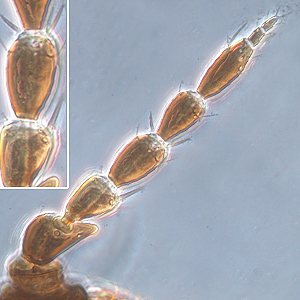Figures
Fig. 1: Antenna (inset: III. and IV. antennal segment)
Fig. 2: Head dorsal with ocellar triangle
Fig. 3: Pronotum
Fig. 4: Meso- and metanotum
Fig. 5: Forewing
Fig. 6: Sternites V and VI
Fig. 7: Tergites VI and VII
Fig. 8: Tergites VIII-IX
ITS-RFLP gel patterns (1&8 ladder, 2 PCR-product, 3 RSAI, 4 HaeIII, 5 MspI, 6 HinfI, 7 AluI)
Fig. 9: Primer pair CS249/CS250
Fig. 10: Primer pair O1/18J
Fig. 11: Primer pair P1/28Z
Taxonomic Information
Species:
Chirothrips aculeatus Bagnall, 1927
Synonyms:
Chirothrips adusta Wetzel, 1963
Chirothrips angusticornis Bagnall, 1932
Chirothrips similis Bagnall, 1925
Pezothrips pedestris Karny, 1910
Common name:
None established
Present taxonomic position:
Family: Thripidae Stephens, 1829
Subfamily: Thripinae (Stephens) Karny, 1921
Genus: Chirothrips Haliday, 1836
Species Recognition
General information about the genus Chirothrips:The species in this genus breed in grass flowers sometimes their pupae are transported around the world within commercial grass seed. This genus has consistent characters that include small heads, antennae with 8 segments, segment II expanded laterally and trapezoidal pronotums.
Typical character states of Chirothrips aculeatus:
Body color
Mainly brown
Antennae
Number of antennal segments: 8
Segments II and III shape: Segment II with external margin strongly prolonged but not III
Segments III & IV sensoria: emergent and simple
Base of sensorium on antennal segment VI: no more than 2 times as wide as base of nearest seta
Terminal antennal segments: rarely elongate
Head:
Distance between bases of ocellar setae III: greater than width of first ocellus
Head shape between compound eyes: distinctly prolonged
Ocellar setae III on head: arising on anterior margin of, or in front of, ocellar triangle
Surface of head, pronotum and fore legs: without strong reticulate sculpture
Ocellar setae I in front of anterior ocellus: present
Prothorax
Number of pairs of elongate pronotal setae: 0-3
Number of pairs of elongate posteroangular pronotal setae: 2
Pronotum shape: trapezoid
Number of pairs of pronotum posteromarginal minor setae: 5
Number of pairs of pronotum anteromarginal minor setae: 2-4
Mesothorax
Mesothoracic endofurca: without median spinula
Metathorax
Metanotal median area sculptured lines: with transverse reticulation
Metanotal median setae length: shorter than lateral metanotal setae
Metanotal median setae position: arising behind anterior margin
Metanotum: without campaniform sensilla
Metanotum major sclerite: with two major sclerites, metascutum and metascutellum
Metanotum median area: with no equiangular reticulation
Metanotum sculpture: without dominant sculptured triangle medially
Metathoracic endofurca: transverse, sometimes with simple median spinula
Wings
Wings: absent, or not longer than thorax width or present and more than half as long as abdomen
First vein of forewing: distinct from costal vein
Forewing anterior margin: with setae and cilia but cilia longer than setae
Forewing color: uniformly light brown
Forewing costal fringe of cilia: arising at anterior margin of wing
Forewing costal setae at middle of wing: shorter than median width of wing
Forewing first vein setal row: incomplete, with setae not closely and uniformly spaced
Forewing posterior margin cilia: undulated near apex
Forewing second vein setal row: incomplete, with setae not closely and uniformly spaced
Forewing surface: not reticulate
Forewings: with veins, setae and microtrichia
Legs
Fore tibial apex: not extending around fore tarsus
Mid and hind tarsi: with two segments
Abdomen:
Abdominal pleurotergites: not covered in microtrichia
Abdominal segment X: never tubular, longitudinally incomplete ventrally in both sexes
Abdominal sternite III of female: without glandular areas
Abdominal sternite VII median marginal setae: arising in front of margin
Abdominal sternites IV , V and VI: with marginal setae but no discal setae
Number of lateral marginal setae on abdominal tergite II: 3
Abdominal tergites: without curved wing-retaining setae
Abdominal tergites IV & V median setal pair: much shorter than distance between their bases
Abdominal tergites V-VII: without paired ctenidia, sometimes with irregular microtrichia
Setae on abdominal tergite X: slender
Surface of lateral thirds of abdominal tergites: without regular rows of fine microtrichia
Ctenidia on tergite VIII: not present, but groups of microtrichia
Tergite VIII posteromarginal comb of microtrichia: absent
Lobes of tergal craspeda: with long detached lobes
Biology
Life history:
As with other thrips species the life cycle from egg to adult is dependent on temperature. The full cycle can take less than one week to over a month and adults may live for more than one month producing several generations in one year depending on seasonal weather (Lewis, 1973).
Host plants:
Grasses (Poaceae)
Vector capacity:
None identified
Current known distribution:
Europe, North America
Additional notes:
Host specificity remains unclear (Goldarazena et al. 1998). The species in this genus breed in grass flowers sometimes their pupae are transported around the world within commercial grass seed.
Bibliography
Bhatti, JS (1990): On some genera
related to Chirothrips (Insecta: Terebrantia: Thripidae). Zoology
(Journal of Pure and Applied Zoology) 2: 193–200.
Goldarazena,
A, Mound, LA & Jordana, R
(1998): Introduccion a la fauna de los Tisanopteros (Insecta,
Thysanoptera) del Pais Vasco, sus plantas hospedoadoras y su distribucion.
I Gipuzkoa. Boletin de la Real Sociedad Espanolade Historia Natural
95:51-57.
Lewis, T (1973): Thrips. Their Biology, Ecology and
Economic Importance. Academic Press, New York, xvi, 350 ppg.
Moritz G, Morris DC, Mound LA (2001): ThripsID - Pest thrips of the world. ACIAR and CSIRO Publishing Collingwood, Victoria, Australia, CDROM ISBN 1 86320 296 X.
Moritz G, Mound LA, Morris DC, Goldarazena A (2004): Pest thrips of the world - an identification and information system using molecular and microscopial methods. CBIT, University of Queensland,CDROM ISBN 1-86499-781-8.
Mound, LA, Morrison, GD, Pitkin, BR & Palmer, JM (1976): Thysanoptera.
Handbooks for the identification of British insects Vol. I, Part 11. Royal
Entomological Society of London.
Zur Strassen, R (1960): Key to and catalogue of the known
species of Chirothrips Haliday,
1836 (Thysanoptera: Thripidae). Journal of the entomological Society
of southern Africa 23: 144-176.
Links:
Mound, LA (2005): Thysanoptera (Thrips) of the World
- A Checklist. http://www.ento.csiro.au/thysanoptera/worldthrips.html












